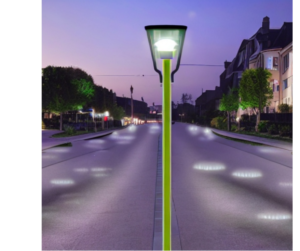Outline
- Introduction
- Understanding Photocells
- Applications of Photocell Light Switch
- Advantages of Photocell Technology
- How to choose the best photocell switch
- Why Chiswear Photocells are best?
- Conclusion
From ancient civilisations to modern-day artificial lighting, humans have sought ways to harness light for practical purposes. Photocell technology represents a pivotal milestone in this ongoing quest, offering a versatile solution that adapts seamlessly to o ur ever-changing environment.
Photocell technology is the cornerstone of numerous applications. By harnessing the power of light, these devices automatically detect changes in ambient brightness, triggering a response that enhances safety, efficiency, and convenience.
This article will explore the intricacies of photocell technology. From its fundamental principles to its diverse array of applications and how to opt for top-tier products, we aim to provide readers with a comprehensive understanding of its significance in today’s world.

Understanding Photocells
Photocells, also known as photo control switches, are electronic devices that possess the remarkable ability to detect changes in ambient light levels and convert this light energy into electrical signals. Fundamentally, photocells operate on the principle of the photoelectric effect, whereby certain materials release electrons when exposed to light.
The core component of a photocell is a semiconductor material, typically made of silicon or cadmium sulfide, which exhibits photoconductivity. This is a property that increases its electrical conductivity in response to light.
When photons from light sources strike the surface of the semiconductor, they energize electrons within the material, causing them to break free from their atomic bonds and generate an electric current.
This resulting electrical signal can then be utilized to activate various devices or systems, such as turning on outdoor lights at dusk or triggering alarms in response to unauthorized intrusions.
Applications of Photocell Light Switch
Photocell technology’s versatility and reliability make it indispensable across a wide range of applications, from illuminating public spaces and conserving energy to enhancing safety and security.
Outdoor Lighting Systems
Photocell light sensor technology plays a crucial role in street lighting systems by automatically turning streetlights on at dusk and off at dawn.
Parking lots often require illumination during nighttime hours to ensure safety and security for vehicles and pedestrians. Street light photocell automatically adjusts their brightness levels based on ambient light conditions, providing adequate lighting while minimizing energy consumption.
This automated approach improves efficiency and reliability while also reducing operational overheads for facility managers.
Automatic Lighting in Homes and Offices
Photocell technology facilitates the implementation of automatic lighting control systems in residential and commercial buildings.
This intelligent lighting management strategy of dusk-to-dawn photocells not only lowers operating costs but also contributes to sustainability efforts by reducing carbon emissions.

Security Systems
Photocell technology is frequently incorporated into motion sensor systems to enhance security and deter unauthorized access. Motion-activated lights equipped with photocells detect movement within their vicinity and illuminate the surrounding area, alerting occupants to potential intruders and discouraging criminal activity.
In more advanced security applications, photocells are utilized as part of intrusion detection systems to monitor perimeters and detect unauthorized entry attempts.
By creating invisible barriers using beams of light, photocell-based intrusion detection systems can trigger alarms or notifications when the beam is interrupted by an intruder.
Advantages of Photocell Technology
Photocell technology offers a multitude of advantages, including energy efficiency, convenience, environmental sustainability, and enhanced safety and security.
Energy Efficiency and Cost Savings
Photocell technology offers significant energy-saving benefits by ensuring that lighting systems operate only when necessary. By automatically adjusting lighting levels based on ambient light conditions, photocells minimize unnecessary energy consumption during daylight hours when natural light is sufficient.
Convenience and Automation
One of the primary advantages of photocell technology is its ability to automate lighting control, enhancing user convenience. This hands-free approach eliminates the hassle of remembering to adjust lights and ensures consistent illumination, whether indoors or outdoors.
Additionally, in smart home setups, photocells can be integrated with other automation devices, allowing for even greater control and customization of lighting preferences.
Environmental Benefits
By optimizing the use of artificial lighting, photocells help minimize the ecological footprint associated with electricity generation and consumption.
Furthermore, by encouraging the adoption of energy-efficient lighting solutions, such as LED bulbs, photocells contribute to reducing overall energy demand and mitigating environmental impact.

Enhanced Safety and Security
The integration of photocell technology enhances safety and security in various settings, from residential neighbourhoods to commercial premises.
By enhancing visibility and reducing opportunities for criminal activity, photocell-enabled lighting solutions contribute to creating safer and more secure communities.
How to choose the best photocell switch
Selecting the right photocell switch is crucial to ensuring optimal performance and compatibility with your specific lighting requirements. Here are some factors to consider when choosing the best photocell switch for your needs:
Application Compatibility
Identify the intended application for the photocell switch, whether it’s for outdoor lighting, indoor lighting, security systems, or other purposes. Ensure that the photocell switch is designed to handle the specific environmental conditions and lighting levels typical of the application area.
Type of Photocell
Consider the type of photocell technology used in the switch, such as cadmium sulfide (CdS) or silicon photocells. Evaluate the advantages and limitations of each type based on factors such as sensitivity, spectral response, and durability.
Some main types of photocells include wire-in photocells, twist lock photocells, Zhage photocells, and smart IOT lighting control systems.
Sensitivity and Adjustment Range
Determine the desired sensitivity level for the photocell switch, which dictates how effectively it responds to changes in ambient light levels. Look for switches with adjustable sensitivity settings to fine-tune the response according to the specific lighting conditions in the installation area.
Operating Voltage and Load Capacity
Verify that the photocell switch is compatible with the voltage rating of the lighting system it will control. Ensure that the switch has an adequate load capacity to support the total wattage of the connected lighting fixtures or devices.
Weatherproofing and Durability
For outdoor applications, choose a photocell switch with weatherproof construction and a high degree of durability to withstand exposure to the elements. Look for switches with robust housing materials, such as UV-resistant polycarbonate or die-cast aluminium, to ensure long-term reliability.
Mounting Options and Installation
Consider the mounting options available for the photocell switch, such as wall-mounted, post-mounted, or flush-mounted configurations. Ensure that the switch’s installation requirements align with the existing wiring setup and mounting location, minimizing installation complexity and cost.
Additional Features and Functionality
Explore any additional features offered by the photocell switch, such as programmable timers, override controls, or compatibility with smart home automation systems. Assess whether these features align with your specific lighting control needs and preferences, enhancing convenience and flexibility.
Warranty and Support
Evaluate the warranty coverage and manufacturer support provided for the photocell switch, ensuring peace of mind and prompt assistance in case of any issues or malfunctions. Look for reputable brands and products with a track record of reliability and customer satisfaction.
Why Chiswear Photocells are best?
Chiswear Photocells stand out as a premier choice in the realm of lighting control technology. Renowned for their exceptional quality, reliability, and innovative design, they offer unparalleled performance in diverse applications.
With advanced features such as adjustable sensitivity, weatherproof construction, and compatibility with various lighting systems, Chiswear Photocells deliver superior functionality and convenience.
Backed by a solid warranty and trusted by professionals and homeowners alike, Chiswear Photocells represent the pinnacle of excellence in the industry, making them the clear choice for discerning customers seeking top-tier lighting control solutions.
Conclusion
The magic of photocell technology illuminates our path toward a brighter, safer, and more sustainable future. From energy efficiency to enhanced safety and convenience, photocells offer myriad benefits across various applications. As we embrace the transformative power of light, let us continue to harness the potential of photocell technology to create more efficient, resilient, and environmentally friendly lighting solutions.
External Links
- https://www.designingbuildings.co.uk/wiki/Artificial_lighting
- https://en.wikipedia.org/wiki/Semiconductor
- https://www.researchgate.net/post/How_does_electricity_affect_Ecological_Footprint_and_how_does_a_high_Ecological_Footprint_affect_the_environment#:~:text=Over%2040%25%20of%20energy%2Drelated,60%25%20of%20humanity’s%20Ecological%20Footprint.https://sciencing.com/types-photocells-5155030.html






